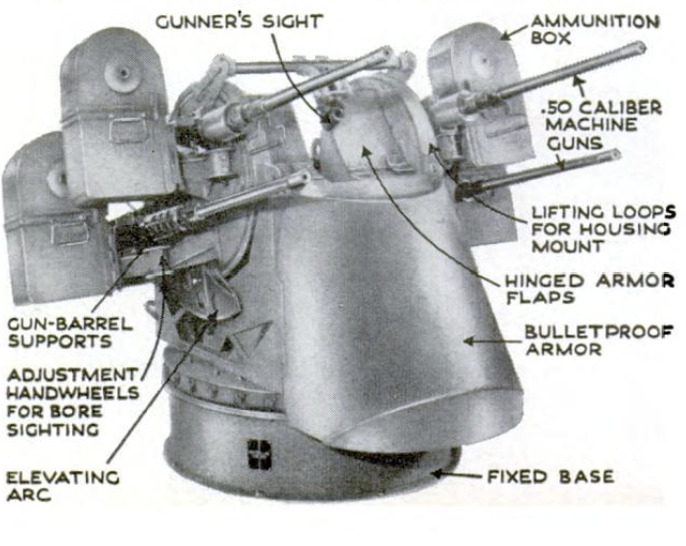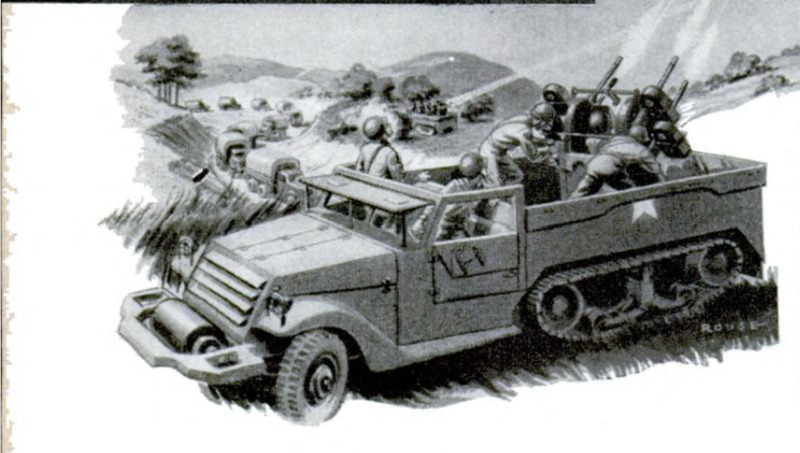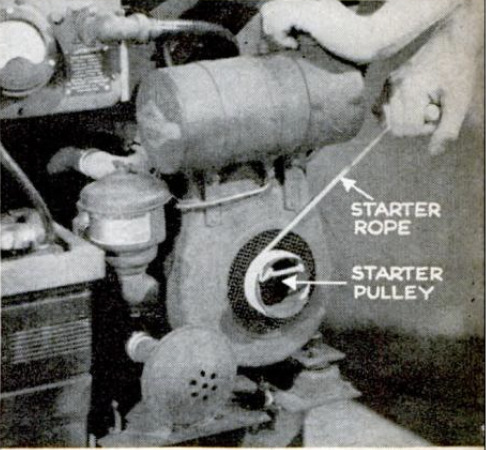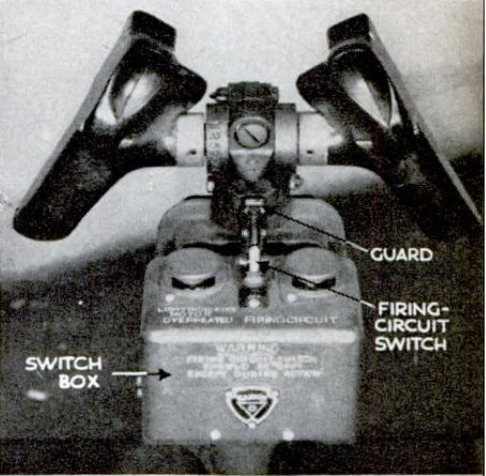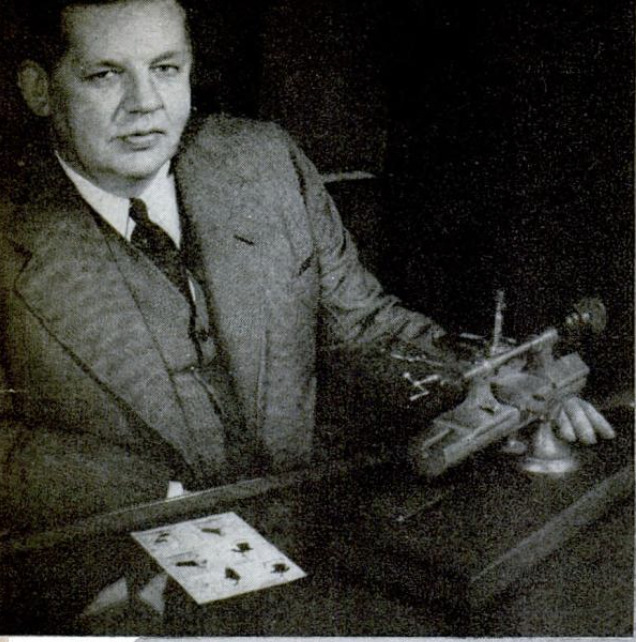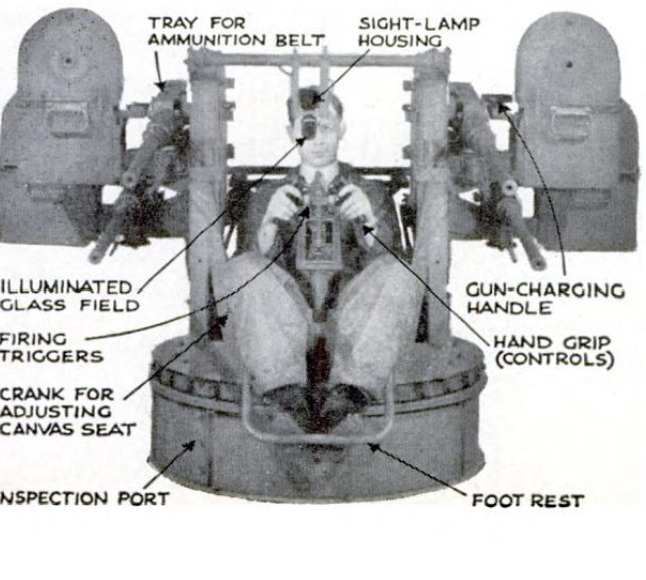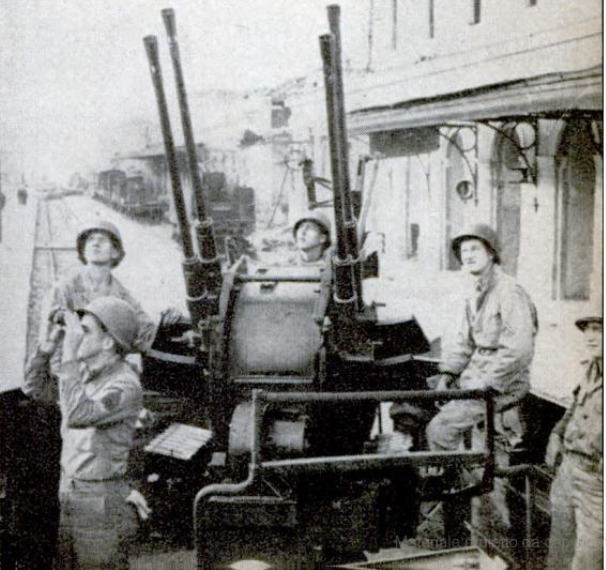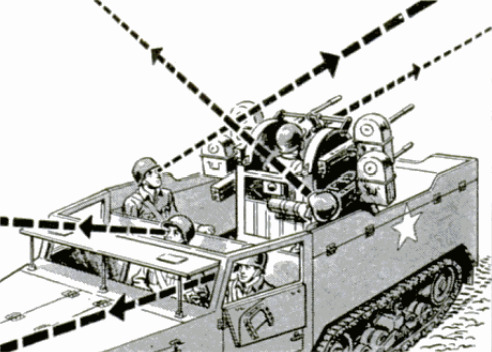-
Title (Dublin Core)
-
Four-gun Maxson machine-gun mount
-
Article Title and/or Image Caption (Dublin Core)
-
He Gave the Wasp Wagon Its Sting
-
extracted text (Extract Text)
-
GIVE a soldier four machine guns, each
weighing 87 pounds, Wrap him in
armor and set him on wheels. Then ask
him to hit a darting, diving Nazi warplane.
It can be done. He can squirt thou-
sands of bullets a minute at that
tricky target as steadily and easily
as a small boy can point a wooden
gun and say uh-uh-uh-uh.
William L. Maxson, a former mid-
shipman from Minnesota, made this
possible by designing for the U.S.
Army a new gun mount that holds
four .50 caliber machine guns. With
this multiple gun mount, the strength
of a man's wrists is so multiplied
that he can wield those four power-
ful, sputtering guns as though they
were a couple of pistols. In fact, the
handles with which he controls them
resemble pistol handles.
Armored and mounted on a half-
track truck or trailer, the Maxson
multiple gun mount is a mobile pillbox. It
has enabled our antiaircraft gunners to
escort moving troops and protect them from
enemy aircraft the way two-gun sheriffs
used to protect stagecoaches from high-
waymen.
Maxson saw the need for such a gun mount late in 1941,
while sitting on a log and chatting with some Army
officers at Aberdeen Proving Ground. They were watch-
ing antiaircraft men experiment with an aircraft turret.
It didn’t work very well.
To land a fatal uppercut during a clinch with a fast,
low plane, a man on the ground obviously needed a heavy
gun. He also needed a support that would permit him
to direct its fire without exerting himself physically.
Otherwise he could not concentrate on aiming. And even
the best marksman would miss if the machinery for
shifting his gun jerked it, or responded too slowly or
too quickly to his touch. Obviously, too, this machinery
should be portable, and its operator should be as well
protected as possible from the attacking plane's fire.
As a specialist in naval gunnery, Maxson was intrigued
by this Army problem. After the last war he had done
three years’ postgraduate work at Annapolis and re-
mained in the uniform of a lieutenant until 1835. Then,
with only $200 capital and only one piece of equipment,
a jeweler's lathe, he had gone into business for himself
in New York. One of his first and most important in-
ventions was a calculating machine to give navigators
their position. Howard Hughes used it on his flight
around the world. It worked and it was adopted by the
Army. But before long someone else found a much
cheaper way to get the same results, and Maxson's pet
product was no longer needed.
Meanwhile, as a consulting engineer for the makers
of Sperry gyroscopes and other intricate electrical and
mechanical devices, “Tuba” Maxson recruited a staff
of engineers, equipped an experimental laboratory, and
enlarged his plant. Much of his concern’s work was on
fire-control apparatus.
Consequently, when the Army ordered a pilot model
of a multiple machine-gun mount from him, four days
after Pearl Harbor, the Maxson organization was rarin’
to go. The pilot model was produced in less than 60 days,
even though some of its parts had to be invented. Tak-
ing the bugs out took a little longer. Then Uncle Sam
reckoned he could use about $100,000,000 worth of
Maxson mounts. The first model carried
only two guns. But a four-gun mount was
soon perfected and thousands of them have
been produced.
The half-tracks that carry Maxson mounts
have been dubbed “wasp wagons.” Brig.
Gen. G. M. Barnes, of the Ordnance De-
partment, has commended the Maxson
engineers for “material assistance in the
furtherance of the national war effort.”
And these mounts have made it possible
for men on the ground to win duels with
Hitler's airmen in Italy.
German antiaircraft gunners in Italy used
a mount carrying four 20-millimeter guns
but requiring a larger crew. Two men are
needed to aim the guns—one to raise or
lower them and another to swing them
horizontally. Those gunners, furthermore,
must stand outside the mount without the
protection of armor.
An American wasp wagon carries only
one gunner, two cannoneers, a driver, and
the squad leader. When in motion, the
squad leader sits beside the driver and
watches the sky ahead; the gunner rides
backward and guards the rear, while the
cannoneers face each other, one looking to
the right and the other to the left.
If a plane is sighted, the cannoneers
spring to the sides of the gun mount. Each
of them is responsible for keeping two
machine guns fed with ammunition and
responsive to the trigger switches. The
squad leader stands behind them and studies
the approaching plane, to determine whether
it is friendly or hostile, while the guns are
being readied.
The gunner sits comfortably in an ad-
justable canvas seat which he can whirl
around like a swivel chair. There are two
machine guns on each side of him and
shields in front that
revolve with him.
He sees his ap-
proaching target
through a glass plate,
onto which a dot and
two circles are pro-
jected from a little
lamphouse and lens
over his head. The
dot shows him when
he has his four guns
trained on the target.
The size of the plane's
image within the cir-
cles on the glass en-
ables him to estimate
its distance, and he
calculates its speed as
he follows it across
the sky.
The guns follow
every movement of his hands. If he swings
the two pistol-like handles which he grips
to the left or right, he changes a set of
pulleys connected by a V-belt, and the motor
in the base below him turns him and the
guns. If he tilts the handles, he changes an-
other set of pulleys linked the same way,
and the motor elevates or lowers the guns.
Portable power for the motor is provided by
storage batteries and a little gasoline-pow-
ered generator.
The gunner can swing his guns 60 de-
grees a second, either horizontally or verti-
cally. He can do a complete about-face, and
point his weapons straight up or 10 degrees
below the horizon. When the guns are
pointed down, the armored sides of the truck
are dropped. When the guns are swung
around so as to bring the driver’s place into
the line of fire, a safety device prevents
them from firing.
The squad leader signals for action as
soon as he is sure the plane sighted is hostile.
Then, as the airman comes into range, the
gunner tightens his grip on the handles
and the guns spurt death like four jets of
water. Their effective range is 1,200 yards,
and a plane can be followed down to within
150 yards. Each barrel can fire from 450
to 750 rounds a minute. Every sixth bullet
usually is a tracer for the gunner’s guidance.
By sighting with one eye and keeping the
other eye open, he can see exactly how he
is doing.
Meanwhile, the squad leader watches for
other attackers. When he spots a new
target, the four guns can be swung on it
almost instantly.
The engineering firm that Maxson started
from scratch only nine years ago now em-
ploys about 1,500 people. Its sales last year
exceeded $10,000,000, and sales of products
designed by the Max-
son Corporation but
produced elsewhere
totaled more than
$50,000,000.
A four-gun Maxson
machine-gun mount
costs about $2,500.
Only a few of its parts
are made now by the
Maxson Corporation.
Most of the manu-
facturing has been
dome by Landers,
Frary & Clark in
Connecticut and the
Kimberly-Clark Cor-
poration in Wisconsin,
in plants built origi-
nally for making pa-
per, refrigerators, and
other products.
-
Contributor (Dublin Core)
-
Volta Torrey (writer)
-
Stewart Rouse (illustrator)
-
Language (Dublin Core)
-
eng
-
Date Issued (Dublin Core)
-
1944-05
-
pages (Bibliographic Ontology)
-
84-86
-
Rights (Dublin Core)
-
Public Domain (Google digitized)
-
Archived by (Dublin Core)
-
Lorenzo Chinellato
-
Alberto Bordignon (Supervisor)
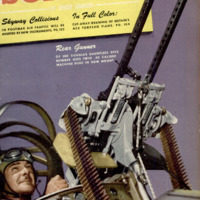 Popular Science Monthly, v. 144, n. 5, 1944
Popular Science Monthly, v. 144, n. 5, 1944

